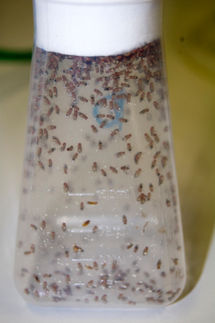No gene is an island
Gene’s neighborhood can influence whether and how the activity of a gene changes
genes do not exist in isolation. Like beads on a string, they sit next to each other on long DNA molecules called chromosomes. So far, little has been known about how the position of a gene on a chromosome affects its evolution. A new study by Călin Guet, Professor at the Institute of Science and Technology Austria (IST Austria), and Magdalena Steinrück, PhD student in Guet’s group, shows that a gene’s neighborhood can influence whether and how the activity of a gene changes.

Bacterial colonies with a fluorescent reporter protein appearing on tetracycline plates over three days (left to right).
Magdalena Steinrück
From bacteria to humans, the way organisms look and function depends a lot on how much product is made from each gene, in other words how active their genes are. The activity of a gene can be changed by mutations, alterations in the DNA that can be inherited. This can make the organism better adapted to its environment – or worse. For example, a bacterium that produces more of a protein that helps it get rid of an antibiotic may survive, while its competitors are killed by the antibiotic. In their study, Steinrück and Guet used experimental evolution to investigate how the position of a gene on the chromosome influences mutations that increase the activity of the gene.
The researchers engineered the DNA of the gut bacterium Escherichia coli to place an antibiotic resistance gene at different positions of its chromosome. This gene allows the bacterium to pump the antibiotic tetracycline out of the cell. At the start of the experiment, the gene was almost completely switched off. The researchers then added more and more tetracycline to the bacteria’s environment. This challenges the bacteria to switch the gene on by mutation, as producing more of the antibiotic resistance gene allows them to pump the antibiotic out, so that they multiply and survive. The authors found that the bacteria were much more likely to survive with the resistance gene in some places of the chromosome than at others. This is because the gene’s neighborhood affects which types of mutations can occur – some forms of mutations can only occur if the neighboring genes permit them to.
“We show that genes can influence the mutation and adaptive potential of nearby genes. The organization of genes on a chromosome is both cause and consequence of evolutionary change”, explains Călin Guet. Their research has vital implications, for example for the global health problem of antibiotic resistance. Magdalena Steinrück: “It is similar to the way humans develop: People in your neighborhood can influence greatly how your future looks like. Our study shows that antibiotic resistance developing from gene activating mutations depends strongly on the gene’s neighborhood.” Chromosome neighborhood effects have not been looked at in detail so far. In future, such findings could help to better estimate whether new antibiotic resistance is to be expected.
Original publication
Other news from the department science

Get the life science industry in your inbox
By submitting this form you agree that LUMITOS AG will send you the newsletter(s) selected above by email. Your data will not be passed on to third parties. Your data will be stored and processed in accordance with our data protection regulations. LUMITOS may contact you by email for the purpose of advertising or market and opinion surveys. You can revoke your consent at any time without giving reasons to LUMITOS AG, Ernst-Augustin-Str. 2, 12489 Berlin, Germany or by e-mail at revoke@lumitos.com with effect for the future. In addition, each email contains a link to unsubscribe from the corresponding newsletter.
More news from our other portals
Last viewed contents

Biotech startup Cradle raises $5.5M to design protein-machines and cell-factories with AI - Cradle’s design platform makes it easy for everyone to start building products with biology instead of oil or animals
VASTox gaint Duchenne Muscular Dystrophy patent






















































